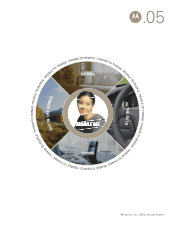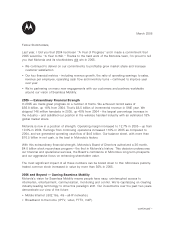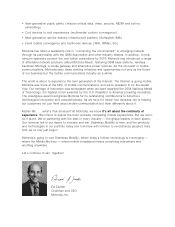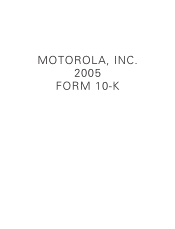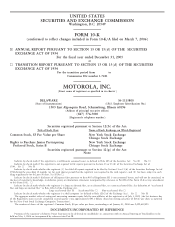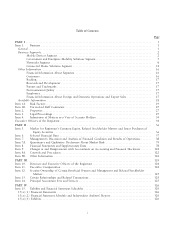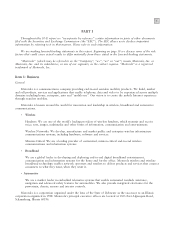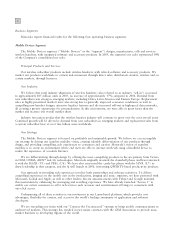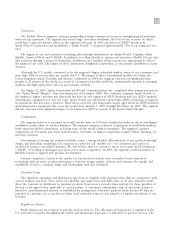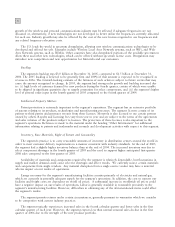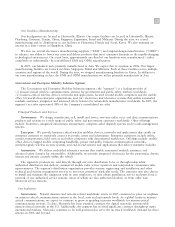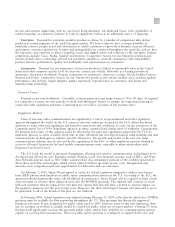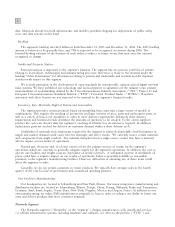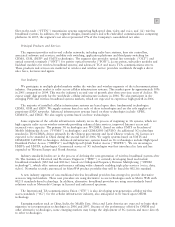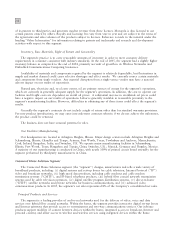Motorola 2005 Annual Report Download - page 11
Download and view the complete annual report
Please find page 11 of the 2005 Motorola annual report below. You can navigate through the pages in the report by either clicking on the pages listed below, or by using the keyword search tool below to find specific information within the annual report.
4
growth of the wireless and personal communications industry may be affected if adequate frequencies are not
allocated or, alternatively, if new technologies are not developed to better utilize the frequencies currently allocated
for such use. Industry growth may also be affected by the cost of the new licenses required to use frequencies and
any related frequency relocation costs.
The U.S. leads the world in spectrum deregulation, allowing new wireless communications technologies to be
developed and offered for sale. Examples include Wireless Local Area Network systems, such as WiFi, and Wide
Area Network systems, such as WiMax. Other countries have also deregulated portions of the available spectrum to
allow these and other new technologies, which can be offered without spectrum license costs. Deregulation may
introduce new competition and new opportunities for Motorola and our customers.
Backlog
The segment's backlog was $3.0 billion at December 31, 2005, compared to $1.5 billion at December 31,
2004. The 2005 backlog is believed to be generally firm and 100% of that amount is expected to be recognized as
revenue in 2006. The forward-looking estimate of the firmness of such orders is subject to future events that may
cause the amount recognized to change. In 2005, the segment had strong order growth and backlog increased due
to: (i) high levels of customer demand for new products during the fourth quarter, certain of which were unable
to be shipped in significant quantities due to supply constraints for select components, and (ii) the segment's higher
level of general order input in the fourth quarter of 2005 compared to the fourth quarter of 2004.
Intellectual Property Matters
Patent protection is extremely important to the segment's operations. The segment has an extensive portfolio
of patents relating to its products, technologies and manufacturing processes. The segment licenses certain of its
patents to third parties and generates revenue from these licenses. Motorola is also licensed to use certain patents
owned by others. Royalty and licensing fees vary from year to year and are subject to the terms of the agreements
and sales volumes of the products subject to licenses. The protection of these licenses is also important to the
segment's operations. Reference is made to the material under the heading ""Other Information'' for additional
information relating to patents and trademarks and research and development activities with respect to this segment.
Inventory, Raw Materials, Right of Return and Seasonality
The segment's practice is to carry reasonable amounts of inventory in distribution centers around the world in
order to meet customer delivery requirements in a manner consistent with industry standards. At the end of 2005,
the segment had a slightly higher inventory balance than at the end of 2004. The increased inventory was due to
select component shortages in the fourth quarter of 2005 and the need to support higher anticipated first-quarter
2006 sales compared to the first quarter of 2005.
Availability of materials and components required by the segment is relatively dependable, but fluctuations in
supply and market demand could cause selective shortages and affect results. We currently source certain materials
and components from single vendors. Any material disruption from a single-source vendor may have a material
adverse impact on our results of operations.
Energy necessary for the segment's manufacturing facilities consists primarily of electricity and natural gas,
which are currently in generally adequate supply for the segment's operations. In addition, the cost to operate our
facilities and freight costs are dependent on world oil prices. A substantial increase in worldwide oil prices could
have a negative impact on our results of operations. Labor is generally available in reasonable proximity to the
segment's manufacturing facilities. However, difficulties in obtaining any of the aforementioned items could affect
the segment's results.
The segment permits returns under certain circumstances, generally pursuant to warranties which we consider
to be competitive with current industry practices.
The segment typically experiences increased sales in the fourth calendar quarter and lower sales in the first
calendar quarter of each year. However, the segment expects less than normal seasonal sales decline in the first
quarter of 2006 due to the strength of the new product portfolio.

